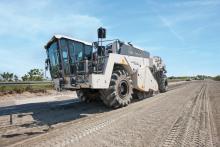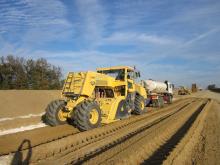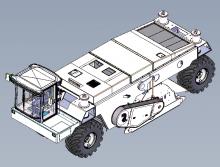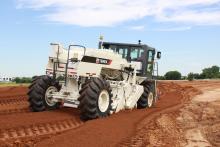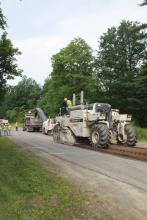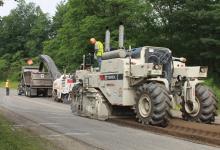Road stabilisers play an important role for road recycling, with new machines coming to market - Mike Woof writes
The reclaimer/stabiliser is becoming a much more important machine in roadbuilding applications now that the construction market is increasing its use of road recycling. The reclaimer/stabiliser used to be a niche machine offered by specialist manufacturers such as CMI, which was a pioneer of the concept. However in recent years this type of machine has become an important construction tool,

The new SX-5 from Roadtec shares features with the firm's larger SX-7
Road stabilisers play an important role for road recycling, with new machines coming to market - Mike Woof writes
The reclaimer/stabiliser is becoming a much more important machine in roadbuilding applications now that the construction market is increasing its use of road recycling. The reclaimer/stabiliser used to be a niche machine offered by specialist manufacturers such as CMI, which was a pioneer of the concept. However in recent years this type of machine has become an important construction tool, with a wide array of models on the market being offered by a range of manufacturers.
Firms in this sector now include
The latest developments in foamed bitumen technologies have boosted the quality of road structure using this type of machine and contractors in developed and developing countries are now using this method for some major road rebuilding projects. Being part of the
Roadtec is launching its SX-5, a mid-sized stabiliser/reclaimer driven by a 403kW Caterpillar C15 engine. This machine has a cutting depth of 460mm, features a drum width of 2.44m and can deliver up to 45kNm of torque to the cutter. The height of the cutter housing combined with the ability to move the drum up or down in the housing allows efficient mixing in the cutter housing. Weighing under 27tonnes, the SX-5 is said to be a high performance machine for its size and has a range of features including water and emulsion systems, an enclosed operator cab, and an array of other options. Four cutting speeds and right-hand flush cut allow the contractor to use the SX-5 for a range of projects including stabilising, pulverising, or cold recycling, while water and emulsion systems and other options are available. With a fuel capacity of 1,136litres the SX-5 can run at full power for 12 hours without the need to refuel. The air intake for the cooling package is located in a clean area on top of the machine. The air filtration system uses a pre-cleaner plus a dual-stage air filter with service indicators. The SX-5 shares components and many performance options with the firm's larger SX-7 reclaimer/stabiliser, which is powered by a 522kW diesel and has a maximum cut depth of 530mm. This machine offers a right-hand flush cut that is 2.59m and despite its size, has a turning radius of just 3.94m in the cut due to its allwheel- steer system. Another novel feature of this machine is that the cutter position can be adjusted in the housing while it is in operation so as to provide optimum gradation and throughput for shallow cuts as well as for deep stabilisation jobs.From SAKAI comes the new PM550, which features a high- torque, two-speed rotor with lateral shift capabilities, allowing the operator to avoid street iron while working up close to obstacles. The machine offers good visibility of the cutting and mixing operation and features four-wheel drive, with a top working speed of 17.7m/min. The machine is powered by a sixcylinder, 370kW
Claimed to be top of the tree in terms of both productivity and performance is the new RS950B reclaimer/stabiliser from Terex Roadbuilding.
This machine is driven by a 708.4kW C27 Caterpillar diesel engine and Terex claims that the machine is now the world's most powerful reclaimer/stabiliser. The machine is said to have over 30% more power than its nearest rival and is said to be the most productive reclaimer/stabiliser on the market. Its power means that the machine is more productive than its rivals whether being used for cutting through tough asphalt reclamation or deep soil stabilisation applications.
The machine features a centre-mount cutter design, which is said to distribute the full machine weight over the housing and helps boost production output. Drive to the cutter drum is through a v-belt array that is said to be up to 25% more efficient than hydrostatic systems. This type of drive also has the advantage that should the drum strike a particularly hard obstruction, the belts can slip rather than causing internal damage. The operators can choose one of four different cutter speeds; 102, 131, 163 and 200rpm to match the requirements of the application. The cutter housing features both front and rear doors, allowing bi-directional cutting in either an up-cut or a down-cut direction, to suit different applications. A 2.49m wide cutter drum is fitted as standard and this features 218 tungsten carbide teeth and can cut to a depth of 406mm.However the firm also offers a 3.05m wide cutter drum and a 1.47m diameter mandrel for cutting depths down to 508mm.
A new control panel is said to make operation and trouble-shooting considerably easier. This shows critical operating system pressures, including charge pressure for the closed-loop hydraulic system. Gauges provide operational readings for the upper and lower cooling fans, propel system, case pressure, auxiliary system and the optional additive system. These instruments help to reduce downtime by highlighting hydraulic system issues should they arise. These factory-installed gauges also eliminate aftermarket installation concerns, such as connecting to the wrong port or difficulty getting the correct fitting to connect to the system.
The machine features four-wheel drive and four-wheel steering, which ensures good traction and manoeuvrability even in demanding applications. High and low-range working speeds are fitted for use when working or when the machine needs to be moved on-site. Another feature is an optional compact compressor that allows service personnel to change cutter teeth without operating the main engine. This new stand-alone compressor is powered by its own 7kW diesel. Servicing and maintenance tasks are also aided by a hydraulic tank mounted toward the outside of the frame for quick access, while the batteries are mounted at ground level inside the machine for quick replacement. The new RS950B shares components with the smaller Terex RS600C, so customers with multiple machines need to stock fewer parts. Other options include a water/emulsion system, rear bolt-on tow attachment, automatic cross-slope system and heavy-duty front housing door.

